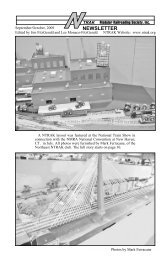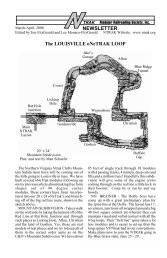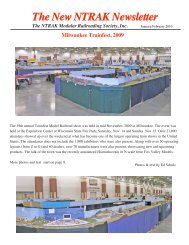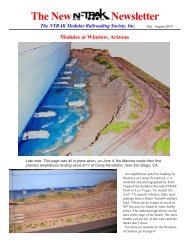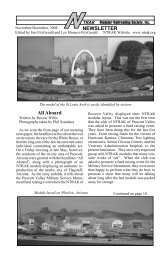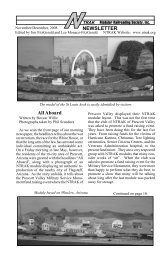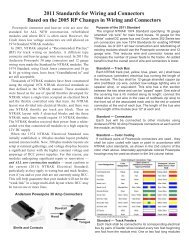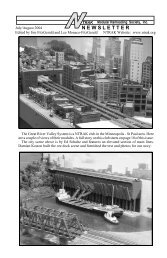The New Newsletter - NTRAK Modular Railroading Society, Inc.
The New Newsletter - NTRAK Modular Railroading Society, Inc.
The New Newsletter - NTRAK Modular Railroading Society, Inc.
Create successful ePaper yourself
Turn your PDF publications into a flip-book with our unique Google optimized e-Paper software.
<strong>NTRAK</strong> Classic and T-TRAK are alive and well. <strong>The</strong><br />
modular standards that have brought thousands of<br />
hours of enjoyment were subjected to the rough-hewn<br />
flooring of a former freight terminal and the 90+ degree<br />
heat and humidity of a Virginia Indian Summer. And<br />
yet, the trains ran level and on time, yielding worn-out,<br />
but smiling faces at show’s end. <strong>The</strong> continuing<br />
popularity of the simple, four-track, oval standard<br />
developed more than 35 years ago is a testament to the<br />
appeal of a basic, functional layout. Many <strong>NTRAK</strong>ers<br />
remain loyal and dedicated to <strong>NTRAK</strong> Classic, a fact<br />
that is not likely to change anytime soon.<br />
<strong>NTRAK</strong> 2.0 is the next generation of <strong>NTRAK</strong>, and<br />
the <strong>NTRAK</strong>ers who braved the Danville Layout, the<br />
all-DCC, dispatcher-assisted, free-style operation are<br />
truly pioneers of <strong>NTRAK</strong>’s uncharted future. Danville<br />
2010 may be the first time an entire National Show<br />
layout was dedicated to full-time operations and digital<br />
control. Pioneering comes with both risk and reward.<br />
Candidly, the reviews of the Danville Layout were<br />
mixed. Interestingly, those operators who have<br />
experienced DCC Operations previously were very<br />
pleased with the integration of dispatcher assistance,<br />
FRS radios, and two-man train crews in color-identified<br />
jerseys completing predetermined assignments. Each<br />
hour of operations offered at least 10 distinctly<br />
different train consists, 20 crew and as many as 8<br />
yardmasters, tower operators and M.O.W. staff.<br />
Experienced operators also appreciated the <strong>NTRAK</strong>compatible,<br />
operations-enhanced modules (OEMs) that<br />
featured remote controlled turnouts, crossovers,<br />
mountain division rise and falls, and ample passing<br />
sidings. Several OEMs were balloon modules at the<br />
end of dog-bones, designed to turn the layout around<br />
without creating an <strong>NTRAK</strong> Classic center pit.<br />
Novice DCC Operators quickly learned how to<br />
overcome some routine challenges. Dirty wheels, dirty<br />
track in light-use territory, intermittent throttle response<br />
due to weak batteries, and split-second delays in the<br />
function of Digitrax reversing devices exemplify<br />
frustrations that experience will help resolve. Lighted<br />
passenger train sets that sputter when crossing reversed<br />
digital districts continue to vex some. <strong>The</strong> added<br />
element of FRS radio traffic from a dispatcher in a<br />
remote room and the concentration involved in<br />
performing pickups and deliveries added to the learning<br />
curve. MOW crews routinely monitored the layout to<br />
identify and resolve issues related to faulty track or<br />
switches, which occasionally wreaked havok on the<br />
trains of new and experienced operators alike. As<br />
<strong>NTRAK</strong> 2.0 moves forward and these challenges are<br />
better understood and rapidly addressed, the positive<br />
impression held by experienced operators will be<br />
shared by novices as well.<br />
Photo of Dispatcher Ed Kerns (RA<strong>NTRAK</strong>) located in separate<br />
room from the layout. Note operations plan on wall, layout plan<br />
with map tacks on table and FRS radios at right. <strong>The</strong> Dispatcher<br />
is speaking to a train crew on the radio.<br />
<strong>NTRAK</strong> Page 7<br />
Operating train crew in colored vests. Conductor (with FRS<br />
radio) on left and engineer (with Digitrax throttle) on right.<br />
Conductor is Tom Metz of RA<strong>NTRAK</strong> and Engineer is Jim<br />
Reske of North Raleigh Model Railroad Club.<br />
Pine Valley Yard (RA<strong>NTRAK</strong>) showing car<br />
markers to assist in operations.



